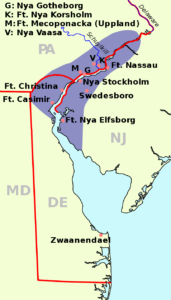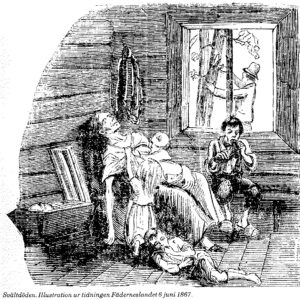Landing in what once was New Sweden
When I first moved here in 2003, I lived in the south of New Jersey, very close to both Delaware and Pennsylvania. Little did I know at that point that I was moving into a part of America that had once been a Swedish colony called New Sweden. So today I want to do a historical overview of Sweden’s presence in America.

New Sweden beginning
As I said new Sweden was a colony in 1638 – 1655, spanning parts of what now is Delaware, Pennsylvania, and New Jersey. It was a small colony with no more than a few hundred residents and lasted for only 17 years before being conquered by the Dutch.
The background and plans of a Swedish territory started in the 1630s when a company named New Sweden Company was formed to exploit the tobacco and fur trade in North America.
The company hired the renowned Dutch explorer Peter Minuit to lead the expedition and two ships, Kalmar Nyckel and Fogle Grip set sail from Sweden in late 1637. Onboard were 25 would-be colonists.
March 1638 they sailed up the Delaware River and landed near what today is known as Wilmington, Delaware. Here, Minuit met with the leaders of the local Lenape and Susquehannock tribes and arranged to purchase the territory that was to become New Sweden.
This specific area was chosen because it’s prime territory for trading with the natives and it was an area not yet occupied by other Europeans.
Here they built the fort Christina, named after the then adolescent Queen of Sweden, and hoisted the Swedish flag.
Improvements needed
The beginnings were meager and for years they only survived by buying corn and other goods from the natives, and nearby British and Dutch settlements. In 1643, a Swedish military officer, Johan Printz, took over as governor. He was determined to extend the reach of the colony and reinforce the fort Christina, and built two new bastions, fort Elfsborg, and fort New Gothenburg, along the Delaware River. They increased their trade with the natives and began to grow food and tobacco on their plantations.
Most of the settlers in New Sweden were native Swedes and Finns and they introduced not only Lutheran Christianity to the area, but also some Scandinavian customs. Most influential was the habit of building log cabins.
The oldest surviving log cabin from this time can be found in Gibbstown, NJ, and is from 1638.
Even after all these improvements the colony never got prosperous like the Dutch or the English. Part of the problem was a lack of manpower and government support from Sweden.
There was almost no interest among people back in Sweden to immigrate to New Sweden and to improve the number of settlers the Swedish Crown eventually started to force petty criminals and military deserters to serve in the colony.
The beginning of the end
The nearby Dutch colony during the years 1647 -1651 started to put pressure on the Swedish colony and restricting the Swedes’ access to the Delaware River and forcing them out of the fur trade.
At the same time, New Sweden had problems internally. Colonists were deserting the settlements in droves and many were deeply dissatisfied with Printz’s way of ruling. This led to him stepping down as governor in 1653 and returning to Sweden.
He was replaced by Johan Rising who arrived with several hundreds of new colonists.
Although he was ordered to avoid danger and hostility with the Dutch he attacked and seized the Dutch fort Casimir. This did not sit well with the Dutch and was the beginning of the end for the Swedes. Just one year later the Dutch retaliated and by sailing seven ships and several hundreds of troops up the Delaware River.
They recaptured their fort Casimir and also defeated fort Christina and several other Swedish holdings on the river.
New Sweden is no more
This was the end of New Sweden after just 17 years, and never again would Sweden have a colony in America. Many Swedes continued to live in the area and it has been reported that as late as the 1750s the Swedish language was still spoken in the area.
After this Swedish immigration to America slowed down until the late 19th and early 20th-century when around 1.3 million Swedes emigrated to the US.

Immigration late 19th early 20th century
Between the years 1851 -1930 1.3 million Swedes emigrated to the US, which was about 25 % of the total population in Sweden.
There was mainly three periods of mass emigration;
1868-1872 about 100,000 Swedes left Sweden, mostly farm families, and most of them relocated to the upper mid-west.
1880-1893 was the largest emigration wave when approximately 475,000 Swedes left their home in Sweden. This time it was not only families, but also loggers, minors, and factory workers.
The American depression of 1893 slowed down immigration for a while.
1901-1914 almost 220,000 Swedes came to America.
By 1910, the U.S. Census recorded over 665,000 Swedish-born persons in the United States.
By 1910 the position of the Midwest as a place of residence for the Swedish immigrants and their children was still strong. Fifty-four percent of the Swedish immigrants and their children now lived in these states, with Minnesota and Illinois dominating. Fifteen percent lived in the East, where the immigrants were drawn to industrial areas in New England. A sizeable Swedish-American community had also been established on the West Coast, and in 1910 almost 10 percent of all Swedish-Americans lived there. There, the states of Washington and California had the largest Swedish-American communities.m Minnesota became the most Swedish of all states, with Swedish-Americans constituting more than 12 percent of Minnesota’s population in 1910. And the city of Chicago was the Swedish-American capital. In 1910, 10 percent of all Swedish-Americans lived there. At the turn of the century, Chicago was also the second-largest Swedish city in the world; only Stockholm had more Swedish inhabitants than Chicago.
According to the 2019 American Community Survey, 3,536,320 Swedish-American lived in the US, or 1.08 % of the total US population.

But why did the Swedes emigrate?
Towards the end of the 1860s, Sweden was hit by several years of crop failure which, in combination with a rapid increase in population and competition for jobs and land. In 1862, the American Homestead Act was enacted and it became important for early emigration. The laws, which were enacted to stimulate farmers to establish themselves on uncultivated land, meant that there was a good supply of cheap land in America, while in many places there was a shortage of land in Sweden. Among the emigrants, there were also motives other than the purely economic ones, such as religious freedom and increased equality.




